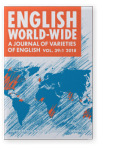Vol. 39:1 (2018) ► pp.34–59
Neologisms
Word creation processes in Hindi-English code-mixed words
Studies in word-formation in English are common compared to the study of new words that are formed by combining the resources of two linguistic systems. Although new word formations within a language are considered to be highly creative, combining words from two different languages provides another level of creativity to bilinguals in different situations. The objective of this paper is to examine the main types of word creation processes employed in mass media texts, particularly in Hindi-English code-mixed words. The focus is on three main processes of word creation: affixation, blending and compounding (including reduplication) and they are discussed from the perspective of productivity/creativity, distribution and underlying motivations. These processes seem to be illustrative of the nativization of inner circle English in India, particularly in mass media where such lexical adaptations lend texts a distinct flavor through innovation in word-formation.
Article outline
- 1.Introduction
- 2.Methodology
- 3.Analysis of Hindi-English code-mixed words
- 3.1Affixation
- 3.2Blending
- 3.3Compounding
- 4.Discussion and conclusion
-
References
This article is currently available as a sample article.
